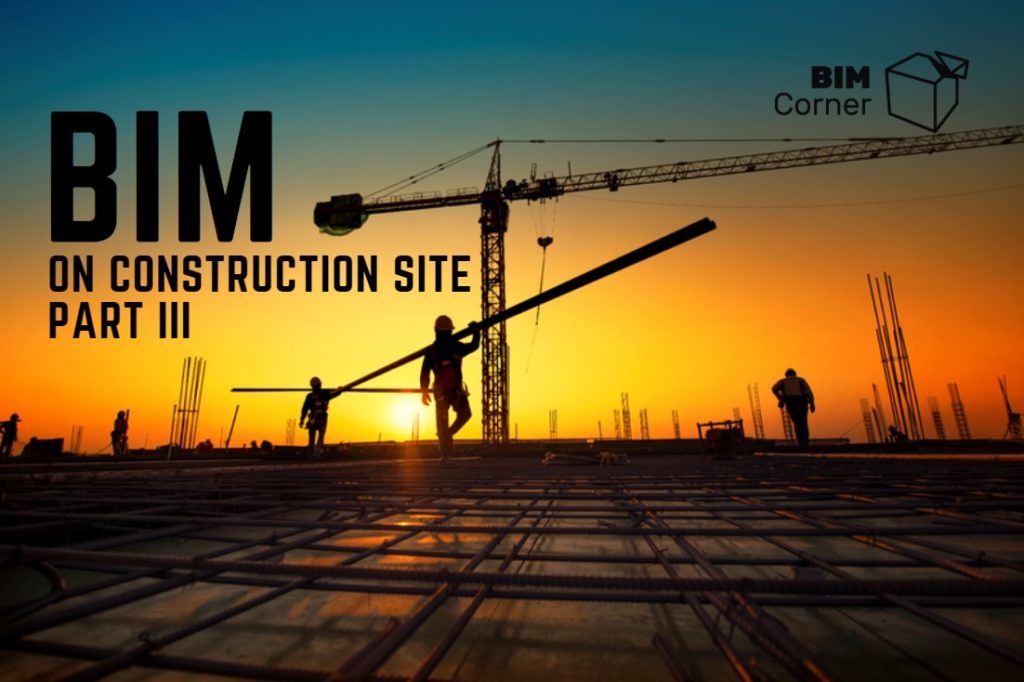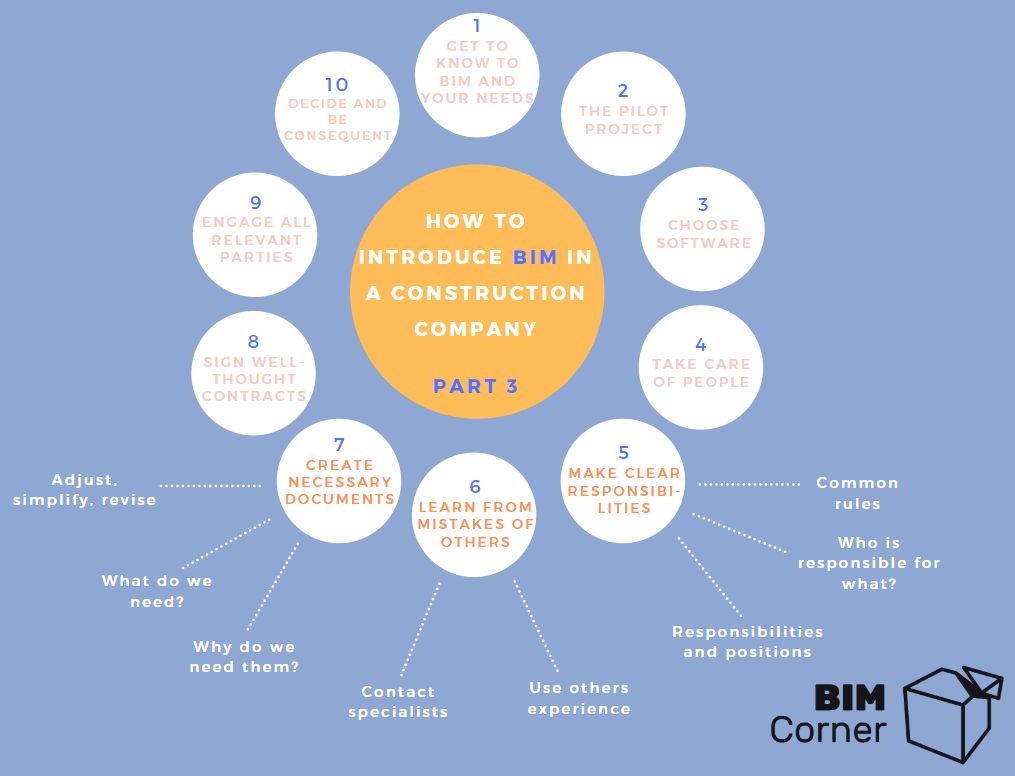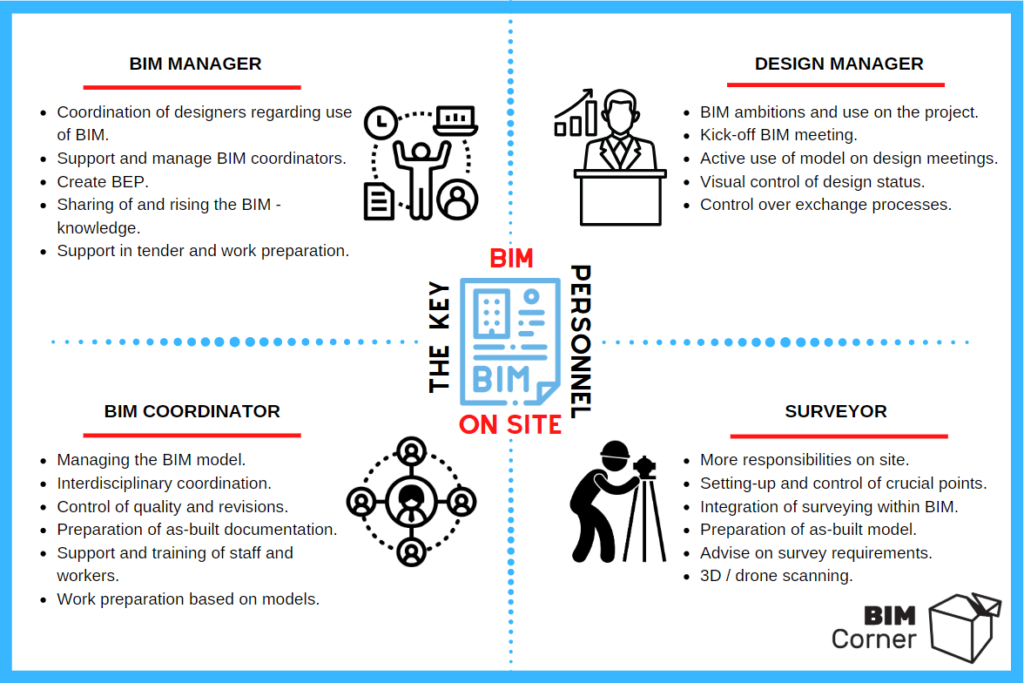Welcome in the third part of the serie ‘BIM on construction site’! As a reminder, in the first article we started with getting to know to the subject and our own needs as well as we encouraged to make a decision about execution of the first pilot project. In the second part you can read about considerations of choosing software and how to take care of people. In today’s article we will focus on responsibilities, learning from other projects, and need for creating relevant documents. Now, it is time to read on!
BIM on construction site - the whole serie in 10 points:
- Identify the subject and your needs. (part 1)
- Execute the pilot project. (part 1)
- Choose the software. (part 2)
- Take care of people. (part 2)
- Make clear responsibilities. (this article)
- Learn from the mistakes of others. (this article)
- Create necessary documents. (this article)
- Sign well-thought contracts.
- Engage all relevant parties.
- Decide and be consequent.
BIM IN CONSTRUCTION COMPANY AND ON SITE - PART 3.
List Of Contents
5. Make clear responsibilities.
Almost every project is carried out by a group of people with different experience, expectations and way of thinking. To pursue one goal together, you need a common understanding of what is required of whom.
A. Common rules.
Let’s start by defining the scope of responsibilities. It should describe not only the tasks themselves, but also the delivered quality that we expect from a given employee and the time it must fit. To achieve a common understanding, we also need to agree on how to check progress and report. It is necessary to check the status of the work throughout the entire duration of the project, and in the event of deviations or adversity, the need for corrective action should be taken.
Defining these tasks in the right way belongs to managers and managers and therefore in this post we will not further develop this topic.
B. Who is responsible for what?
Throughout the whole construction industry, different companies have different job names when it comes to working with BIM. It can be, for example, BIM Engineer, BIM Architect, BIM Modeler, ‘Head of BIM’, ‘BIM Champion’, or BIM coordinator and BIM manager, on which we will focus below. The name is not important, but the mutual understanding of tasks and responsibilities. There is no one common standard for this, so each company / project must adapt it to their needs.
Example of responsibilities of key personnel working with BIM on site.
BIM coordinator
We have already written about the BIM coordinator in a separate series.
It is worth remembering, however, that the tasks and duties of a BIM coordinator in an execution company may differ significantly from those of design companies. The BIM coordinator at the construction site will devote a large part of his time to the support of other staff and construction workers, and often to the preparation of drawing documentation for the needs of his company. His examples of duties as a contractor are:
- Digital model management.
- Multidisciplinary coordination.
- Preparation of construction documentation for the purpose of carrying out works.
- Quality control and revision of models.
- Preparation of as-built documentation.
- Staff support in working with BIM models.
- Training of construction workers in the use of models and software.
- Cooperation with cost estimators, schedulers, suppliers, subcontractors and the client.
BIM manager
BIM manager is sometimes referred to as a BIM coordinator who has a lot of practical experience. It happens that these roles often overlap. In the contractor company he may have the following responsibilities:
- Coordination of designers in the use of BIM technology for ‘design and build’ projects.
- Support and management of BIM coordinators on construction sites.
- Creating a BEP document – BIM Execution Plan – describing work practices within a company.
- Raising awareness of the use of BIM technology throughout the organization with proper training and knowledge transfer.
- Support of the tender department when bidding on new projects.
Design Manager
The design manager, the person managing the design process on ‘design and build’ projects, has key tasks related to the use of BIM technology in the organization. The most important of these include:
- Decision on the BIM-ambition on the project and necessary modeling requirements.
- Conducting the first kick-off BIM-meeting with relevant participants of the construction process.
- Active use of the model during meetings and for managing the design process.
- Carrying out visual inspection of the model with a view to current design activities.
- Checking whether the exchange of models between disciplines and their update is proceeding as planned (e.g. once a week).
- Control of design status in accordance with the agreed schedule.
Surveyors
It is worth remembering the additional responsibilities of other participants of the construction process, such as surveyors. By switching from 2D to 3D and the desire to eliminate drawings, they are often forced to accept more tasks at the construction site. This is due to the fact that workers, especially in the early stages, are not sure how to use the 3D model to take dimensions. For them it is much easier in this case to ask surveyors to mark out a given structure or its elements, such as door openings. It can also happen that in the software that we are using, not everything can be accurately measured from the model. Therefore, at the beginning of the project (and even in the tender phase), it is necessary to agree together what are the tasks and responsibilities of surveyors and how many of them we need at the construction site, during different stages of the project.
C. Responsibilities and positions - the real needs.
Each project differs from each other in size, scope, complexity, execution time and many other variables. This should be taken into account already during the bidding process and while establishing the staff needed to carry out the construction. You have to be painfully realistic in any case. Let’s look at the following examples of projects where the use of BIM technology is planned, from the perspective of determining positions. As we can see, the responsibilities and tasks of people who are theoretically in the same positions may differ significantly:
1. Construction of an industrial hall with an area of 1200 m2, design is provided by the client in the form of a 3D model.
We assume that we can fabricate most of elements of such a hall. Therefore, we do not need a very large organization when it comes to the proper use of BIM: for example, one BIM-coordinator who prepares the documentation for works on site from the model for workers, ‘enriches’ the 3D with new elements such as temporary elements, provides technical support to the staff and workers and updates the model to as-built documentation. In addition, if necessary, we can assume that one construction engineer or trainee will support the BIM manager in his duties.
2. Construction of a 18 km highway section with 10 bridge structures in the design and build tender. Requirement to use BIM in each phase of the project.
When the entire project should be made in the BIM technology and we are responsible for the design, our needs for the BIM-staff will increase significantly. In this case, for example, we can assume the need for: 1 BIM manager, 2 BIM coordinators, 4-5 surveyors, 2 design managers, 2 BIM engineers, etc.
Of course, these are just considerations to illustrate that each project is different and that each time we have to look at our real needs.
6. Learn from the mistakes of others
A good reference is to start with a quote from Eleanor Roosevelt: “Learn from the mistakes of others. You can’t live long enough to make them all yourself.” Working with BIM on the construction site and implementing this technology, even though it seems to be something new to us, in fact has been used for several years in various places all around the world. Not everyone has to go through everything from the beginning and make the same mistakes.
A. Use the experience of other companies and organizations.
There exists infinite knowledge on the Internet from which you can learn about carrying out projects using BIM technology. However, the biggest challenge today is finding the right quality information. Unfortunately, for various reasons, many companies only show things that:
1) They want to show – because they do not want to share their key information with others,
2) Went well – because hardly anyone likes to admit a mistake.
Therefore, we always advise you to verify the data that you find on the Internet. Another important consideration is checking when the article, book or presentation has been published. With such a rapidly evolving technology, most studies over 3 years old are no longer valid and do not show current BIM capabilities.
Let’s assume, however, that we got interested in a specific project carried out using BIM and we want to learn more about it. In this case, a good approach is to look for information directly at the source – finding people who worked on it. There is a possibility that they have made some presentations at conferences, and if not, direct contact on LinkedIN can work wonders. Many people, asked directly, share their knowledge more willingly, having interaction with only one person.
Another method to learn from the mistakes of others is to participate in conferences and webinars. It is true that again a situation may arise that only superlatives are showed in the presentation itself. But in this case it is much easier to approach the person after the lecture and ask questions that bother us.
B. Contact the specialists.
We have already written about the need for courses and training in the second part of the series.
We have briefly listed their advantages and disadvantages. If we want to introduce BIM in our organization and on the construction site, it may be a good idea to consult with experts about our special needs. This means that we do not arrange a standard course about the basics of BIM or a given software, but we contact the company / person conducting the training and ask for an individual approach to the issues that really interest us. It is worth focusing on one or two issues at a time in this case. For example:
- Cost estimation – introducing BIM in the bidding process.
- The use of BIM at the construction site in a ‘no drawings’ project.
- Showing and updating the construction schedule in BIM technology.
When deciding to contact a specialist, it is extremely important that we have total confidence in that person. You should check his or her qualifications and experience. The consultant must have practical knowledge of carrying out similar processes in the past. After verifying the person or the company with whom we want to cooperate, let’s plan an initial meeting at which we want to express our expectations and agree on the amount of time as well as the budget and quality of the services. We wrote about the SMART method in setting goals in the first part of the ‘BIM in the execution company and on the construction site’-series.
7. Create necessary documents.
A. Why do we need them?
As we have written many times before, communication is one of the most important things that you need to take care of in your company. The understanding of expectations, responsibilities and requirements by all participants in the construction process is crucial to achieve success and the planned level of implementation of BIM technology.
B. What do we need?
Again, each project should be approached individually. It may turn out that on some of them we will only need basic documents (like BEP or BIM manual), and on others we need to prepare more procedures. Below are the most-used ones – however, the list could be much longer. It should also be noted that depending on the country and companies in which we work, there are different practices in terms of types and content of documentation. For example, in some organizations BIM Manual has taken over the role of BEP, and in others it is BEP that is the living document:
- BEP – or BIM Execution Plan, about which we wrote in this article. In one sentence, BEP is a plan that defines the goals and ways of using BIM technology in our organization.
- BIM Manual – should describe the principles of working with BIM on a specific project. This document should be kept up to date. The BIM manual usually consists of two parts. The first contains a general, standard description of working with BIM in our company, while the second part contains project-specific information.
- Document on managing a multi-disciplinary model – it should describe the procedures for working with the model.
- The procedure for using the CDE (Common Data Environment) platform and communication within project.
In addition, as part of the above-mentioned or as separate documents, we should describe key procedures / practices, such as:
- How to add data to the .ifc model or add temporary structures to a 3D model, such as scaffolding or formwork.
- How to put dimensions on objects.
- How to create a reinforcement / bending list from a 3D model.
- A way of communicating with the client and other project participants, such as suppliers or subcontractors.
- How to use a BIM kiosk or iPad on site.
C. Important to remember.
- Each document or procedure should be tailored to the project. The “copy + paste” method does not work in this case.
- Simplify descriptions and keep only what is necessary and relevant in a given document. Remember that those procedures will be used by people with different experience. Keep it simple and use the KISS method (Keep It Simple, Stupid).
- If something is not needed – do not produce it! Reduce the number of documents to the necessary minimum.
The documents and procedures should be ‘living’ – that is, modified on a regular basis, depending on the needs and possible improvements. Revisions and updates will be required and it is important that the person responsible for the file performs them.
Summary of the third part of BIM in construction company and on site.
In the third part of the serie ‘BIM on the construction site and in the execution company’, we looked at issues related to responsibilities and documentation. We also proposed to use the experience of other organizations, thus avoiding making similar mistakes. All the time, however, we must ask ourselves and have those questions in our head: what do we need BIM for and what do we want to achieve with it? What is our priority? How can we, using this technology, develop ourselves and our company to ultimately save time, money and be more competitive on the market?
Do you use BIM in your company or on your construction site? Do you have a clear responsibility and mutual understanding about who does what? What documents have you developed and used?
Share your experiences below with us in the comments or write to us at [email protected]!
Check out other articles about BIM in construction company and on site:











